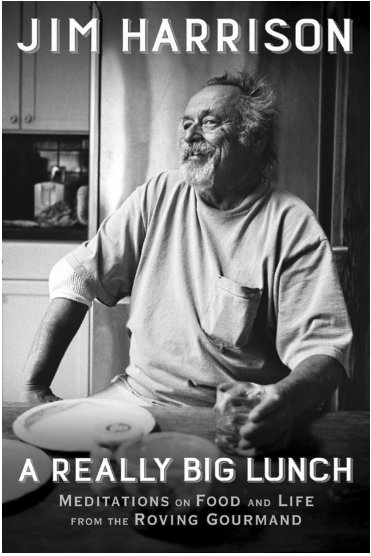The cover of Harrison’s new book, “A Really Big Lunch: Meditations on Food and Life from the Roving Gourmand,” shows the bearded, one-eyed writer in his kitchen, drink in hand, a pack of Spirits in his T-shirt pocket and an empty plate in front of him. The new book, about one of many of Harrison’s excesses, is a beautifully written companion piece to his 2001 gourmand delight “The Raw and the Cooked: Adventures of a Roving Gourmand,” a collection of his food columns, mostly from Esquire, Smart and Men’s Journal magazines.
“A Really Big Lunch” picks up where “The Raw and Cooked” left off, covering 15 years of his passion for eating. Harrison’s great friend and renowned chef Mario Batali provides a sizzling appetizer in an introduction to the book, in which Batali recalls the first time Harrison showed up at his New York restaurant, Babbo.
“ That night we ate just about every non-grocery store cut of every animal I served,” Batali writes. “The meal ran to 15 courses: from one of Jim’s favorites, our Babbomade testa, with my dad’s finocchiona and culatello, to lamb’s tongue vinaigrette, tripe in the style of Parma, and both beef cheek and calf’s brains raviolis ... .”
And on and on through dessert. Having eaten with Harrison, I can testify his offerings are not for those whose constitution may lean toward gout. Harrison worshipped the innards of animals, from heart to stomach, but he was not one to turn away the rest, from the butt to nose and from ears to toes.
We once compared his recipe for head cheese, which appeared in an Esquire column, to my grandmother’s. “Take one pig’s head, place in large pan, add water, boil for 24 hours … .”
He liked my grandmother’s addition of bits of hot pepper.
Harrison also liked to take his time eating. Dinner could take three to four hours, with course upon course piling up on the table, each punctuated with French wine — and only French wine.
Once, when asked about Michigan wines, he responded “life’s too short” to drink anything but French wine.
The chapters on eating in his newest book are mostly taken from contributions he made to literary journal “Brick,” Smoke Signals magazine and the newsletter of the Kermit Lynch Wine Merchant, where he traded his musings for cases of wine instead of cash.
One notable exception is the book’s namesake, “A Really Big Lunch,” which set off cries of disgust when it appeared in the New Yorker in 2004. The article relives the time he and 11 others flew to France to devour a 37-course lunch.
In writing about it, he compared the cost to that of a “new Volvo station wagon.” He includes the complete menu and all the wines that wash it down. As he waits for an Air France flight to return him to the U.S., he laments, “As with sex, bathing, sleeping, and drinking, the effects of food don’t last.”
There is one outlier in this collection, a piece he wrote for Martha Stewart Living titled “Close to the Bone.” In it, he relays the simple joys of cooking meat, both wild and domestic. He cites an early edition of “Joy of Cooking” for his version of head cheese and tells of the joy of grilling a cabrito, or young goat.
He and I once had a discussion about “Joy of Cooking,” which Harrison thought was a beautiful portrait of a woman who, experiencing grief over the loss of her husband, decides to sit down and write a cookbook.
(“Joy of Cooking,” first published in 1931, was written by Irma S. Rombauer while she was summering in Northern Michigan. Early versions had recipes for preparing wild game that do not appear in later editions.)
You also will find in Harrison’s columns simple lessons on morality and food, as well as meditations on his deep friendships, which often played out over food. He is often gruff and to the point, like when he describes how dating and food has found a “brutish place” in America: “I predict within a year you’ll be able to couple with a pretty girl by buying her a McDonald’s Quarter Pounder.”
Harrison loved food, but he was not a food snob. He would delight in simple menudo or queue up outside a food truck with the rest of us. I know for certain he was a fan of fry bread, a Native American pow wow staple.
The book only lacks one thing, and that is a dictionary of terms. To read and understand what the many dishes are — like jamon de jabugo, for example — you’ll need a food dictionary or a nearby smartphone with Google open. And to really experience it, you’ll need a hefty checking account balance, because that Iberian pig runs more than $100 a pound.
Support City Pulse - Donate Today!
Comments
No comments on this item Please log in to comment by clicking here